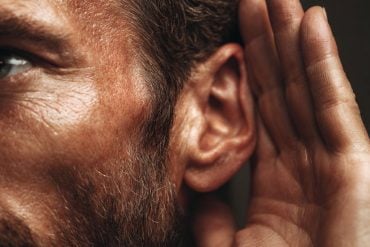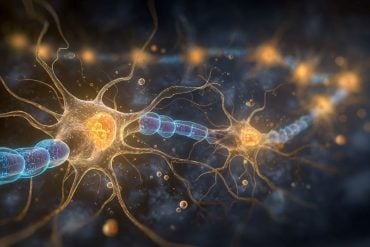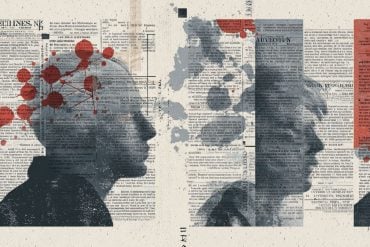Summary: Researchers link symptoms of difficulty in understanding speech in noisy environments with hidden hearing loss in college aged people.
Source: Mass Eye and Ear.
Researchers from Massachusetts Eye and Ear have, for the first time, linked symptoms of difficulty understanding speech in noisy environments with evidence of cochlear synaptopathy, a condition known as “hidden hearing loss,” in college-age human subjects with normal hearing sensitivity.
In a study of young adults who may regularly overexpose their ears to loud sounds, a research team led by Stéphane Maison, Ph.D. (pictured above at a hearing screening for music students), showed a significant correlation between performance on a speech-in-noise test and an electrophysiological measure of the health of the auditory nerve. The team also saw significantly better scores on both tests among subjects who regularly wore hearing protection when exposed to loud sounds. Their findings were published online today in PLOS ONE.
“While hearing sensitivity and the ability to understand speech in quiet environments were the same across all subjects, we saw reduced responses from the auditory nerve in participants exposed to noise on a regular basis and, as expected, that loss was matched with difficulties understanding speech in noisy and reverberating environments,” said Dr. Maison, an investigator in the Eaton-Peabody Laboratories at Mass. Eye and Ear and Assistant Professor of Otolaryngology at Harvard Medical School.
Hearing loss, which affects an estimated 48 million Americans, can be caused by noise or aging and typically arises from damage to the sensory cells of the inner ear (or cochlea), which convert sounds into electrical signals, and/or the auditory nerve fibers that transmit those signals to the brain. It is traditionally diagnosed by elevation in the sound level required to hear a brief tone, as revealed on an audiogram, the gold standard test of hearing sensitivity.
“Hidden hearing loss,” on the other hand, refers to synaptopathy, or damage to the connections between the auditory nerve fibers and the sensory cells, a type of damage which happens well before the loss of the sensory cells themselves. Loss of these connections likely contributes to difficulties understanding speech in challenging listening environments, and may also be important in the generation of tinnitus (ringing in the ears) and/or hyperacusis (increased sensitivity to sound). Hidden hearing loss cannot be measured using the standard audiogram; thus, the Mass. Eye and Ear researchers set out to develop more sensitive measures that can also test for cochlear synaptopathy.

Diagnostic measures for hidden hearing loss are important because they help us see the full extent of noise-induced damage to the inner ear. Better measurement tools will also be important in the assessment of future therapies to repair the nerve damage in the inner ear. Mass. Eye and Ear researchers have shown in animal models that, under some conditions, connections between the sensory cells and the auditory nerve can be successfully restored using growth factors, such as neurotrophins.
“Establishing a reliable diagnosis of hidden hearing loss is key to progress in understanding inner ear disease,” said Dr. Maison. “Not only may this change the way patients are tested in clinic, but it also opens the door to new research, including understanding the mechanisms underlying a number of hearing impairments such as tinnitus and hyperacusis.”
Funding: Research supported by NIDCD RO1 DC00188 and NIDCD P30 DC 05209.
Source: Suzanne Day – Mass Eye and Ear
Image Source: NeuroscienceNews.com image is credited to Garyfallia Pagonis.
Original Research: Full open access research for “Toward a Differential Diagnosis of Hidden Hearing Loss in Humans” by M. Charles Liberman, Michael J. Epstein, Sandra S. Cleveland, Haobing Wang, and Stéphane F. Maison in PLOS ONE. Published online September 12 2016 doi:10.1371/journal.pone.0162726
[cbtabs][cbtab title=”MLA”]Mass Eye and Ear “Evidence of Hidden Hearing Loss in College Aged People.” NeuroscienceNews. NeuroscienceNews, 12 September 2016.
<https://neurosciencenews.com/hearing-loss-college-students-5026/>.[/cbtab][cbtab title=”APA”]Mass Eye and Ear (2016, September 12). Evidence of Hidden Hearing Loss in College Aged People. NeuroscienceNew. Retrieved September 12, 2016 from https://neurosciencenews.com/hearing-loss-college-students-5026/[/cbtab][cbtab title=”Chicago”]Mass Eye and Ear “Evidence of Hidden Hearing Loss in College Aged People.” https://neurosciencenews.com/hearing-loss-college-students-5026/ (accessed September 12, 2016).[/cbtab][/cbtabs]
Abstract
Toward a Differential Diagnosis of Hidden Hearing Loss in Humans
Recent work suggests that hair cells are not the most vulnerable elements in the inner ear; rather, it is the synapses between hair cells and cochlear nerve terminals that degenerate first in the aging or noise-exposed ear. This primary neural degeneration does not affect hearing thresholds, but likely contributes to problems understanding speech in difficult listening environments, and may be important in the generation of tinnitus and/or hyperacusis. To look for signs of cochlear synaptopathy in humans, we recruited college students and divided them into low-risk and high-risk groups based on self-report of noise exposure and use of hearing protection. Cochlear function was assessed by otoacoustic emissions and click-evoked electrocochleography; hearing was assessed by behavioral audiometry and word recognition with or without noise or time compression and reverberation. Both groups had normal thresholds at standard audiometric frequencies, however, the high-risk group showed significant threshold elevation at high frequencies (10–16 kHz), consistent with early stages of noise damage. Electrocochleography showed a significant difference in the ratio between the waveform peaks generated by hair cells (Summating Potential; SP) vs. cochlear neurons (Action Potential; AP), i.e. the SP/AP ratio, consistent with selective neural loss. The high-risk group also showed significantly poorer performance on word recognition in noise or with time compression and reverberation, and reported heightened reactions to sound consistent with hyperacusis. These results suggest that the SP/AP ratio may be useful in the diagnosis of “hidden hearing loss” and that, as suggested by animal models, the noise-induced loss of cochlear nerve synapses leads to deficits in hearing abilities in difficult listening situations, despite the presence of normal thresholds at standard audiometric frequencies.
“Toward a Differential Diagnosis of Hidden Hearing Loss in Humans” by M. Charles Liberman, Michael J. Epstein, Sandra S. Cleveland, Haobing Wang, and Stéphane F. Maison in PLOS ONE. Published online September 12 2016 doi:10.1371/journal.pone.0162726






